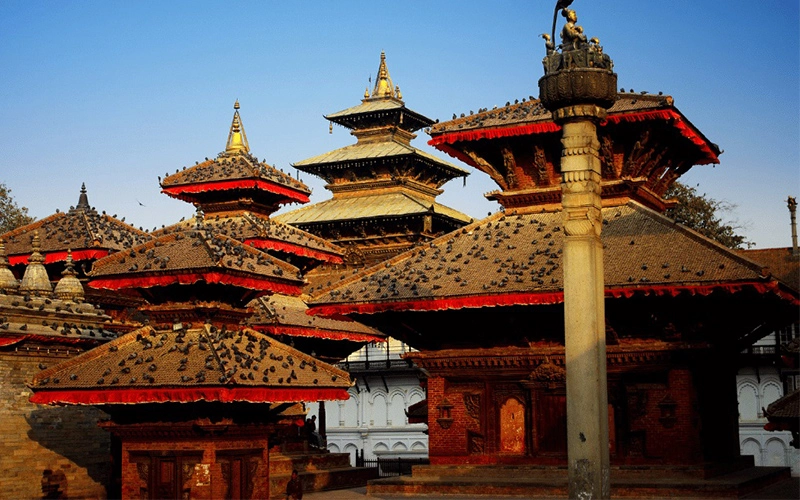Pashupatinath Temple-A Sacred Abode of Lord Shiva
- Best price guaranteed
- No booking fees
- E-ticket/Mobile voucher

OVERVIEW
Warning: Undefined array key "highlights" in /home/u506218847/domains/tourofnepal.com/public_html/wp-content/themes/tourofnepal/single.php on line 109
-
ITINERARY
Pashupatinath Temple, one of the most revered Hindu temples in Nepal, is devoted to Lord Shiva. This sacred site, built in the 5th century and later renovated by the Malla Kings, holds immense religious significance for Shiva devotees across Asia. Legend has it that the temple existed since the discovery of a Shiva lingam at the site, making it a place of deep spiritual importance.
The sprawling temple complex, situated on both sides of the Bagmati River, a river considered holy by Hindus, features a magnificent pagoda-style sanctuary with a gilded roof, silver-covered doors, and intricate wooden carvings. Surrounding the main temple are numerous shrines dedicated to Hindu and Buddhist deities. Only Hindus are allowed within the inner sanctum, which houses the Shiva lingam, while non-Hindus can view the temple from the banks of the Bagmati.
A significant attraction within the complex is the nearby Guheshwori Temple, dedicated to Shiva’s consort, Sati Devi. The banks of the Bagmati are also the site of traditional Hindu cremation rituals, offering a solemn insight into the Hindu beliefs on life, death, and reincarnation. Maha Shivaratri, a major festival celebrating Lord Shiva, attracts countless devotees to Pashupatinath every spring.
Visitors to the temple can explore its vast surroundings, which include 492 temples, 15 Shivalayas (shrines of Lord Shiva), and 12 Jyotirlingas (phallic shrines). The site, a UNESCO World Heritage Site, is not just a religious center but also a cultural and spiritual haven that embodies the timeless spirit of Hindu traditions.
Brief History of Pashupatinath Temple
The exact date of the Pashupatinath Temple’s construction remains uncertain, though evidence suggests that the temple dates back to at least 400 A.D. The current main temple was rebuilt in the 17th century after the previous structure was destroyed by termites. Many smaller shrines and temples have since been erected on the riverbanks.
According to a popular legend, Lord Shiva, in the guise of a deer, roamed the forests near the Bagmati River. When divine forces attempted to return him to his cosmic duties, Shiva lost an antler, which became the original lingam worshipped at Pashupatinath. Later, a herder’s cow uncovered the lost lingam, leading to the construction of the temple.
Interesting Facts About Pashupatinath Temple
1. Historical Significance: The temple has existed since at least 400 A.D., making it one of the oldest and most significant religious sites in Nepal.
2. Origin Legend: The temple’s origin is linked to the discovery of a Shiva lingam by a cow, as described in local legends.
3. Architectural Beauty: The temple boasts a cubic structure with a gilded roof, silver-covered doors, and exquisite wood carvings.
4. Unique Lingam: The Shiva lingam here is four-faced, each representing different aspects of Lord Shiva.
5. Hindu-Only Access: Only Hindus are allowed inside the main temple complex, while non-Hindus can view from the surrounding areas.
6. Rich Artwork: The temple is adorned with intricate paintings and sculptures, many of which depict Hindu deities and figures.
7. Arya Ghat: This ghat along the Bagmati River is considered sacred and is used for royal and public cremations.
8. Nirvana Belief: It is believed that those cremated at Pashupatinath are reincarnated as humans, regardless of their earthly sins.
9. Open-Air Cremations: Visitors can witness the peaceful, yet profound, Hindu cremation ceremonies along the Bagmati River.
10. Survived the 2015 Earthquake: The temple remarkably withstood Nepal’s 2015 earthquake with minimal damage, showcasing its resilient architecture.
Pashupatinath offers a unique blend of religious, cultural, and spiritual experiences, and is a must-visit for anyone seeking to immerse themselves in the rich traditions of Hinduism.
WHAT'S INCLUDED
Warning: Undefined array key "include" in /home/u506218847/domains/tourofnepal.com/public_html/wp-content/themes/tourofnepal/single.php on line 129
WHAT'S EXCLUDED
Warning: Undefined array key "exclude" in /home/u506218847/domains/tourofnepal.com/public_html/wp-content/themes/tourofnepal/single.php on line 146